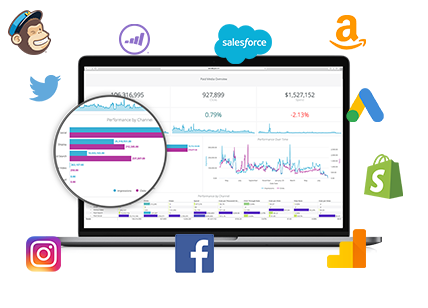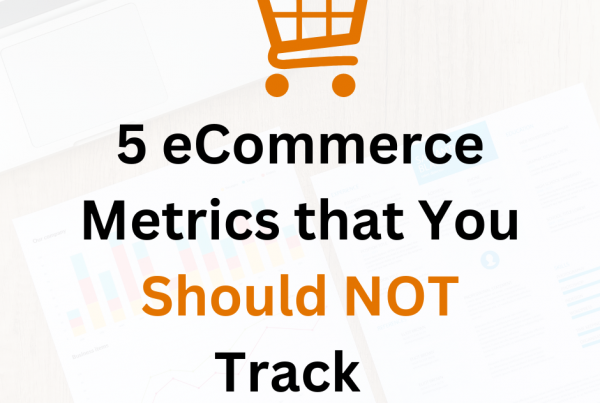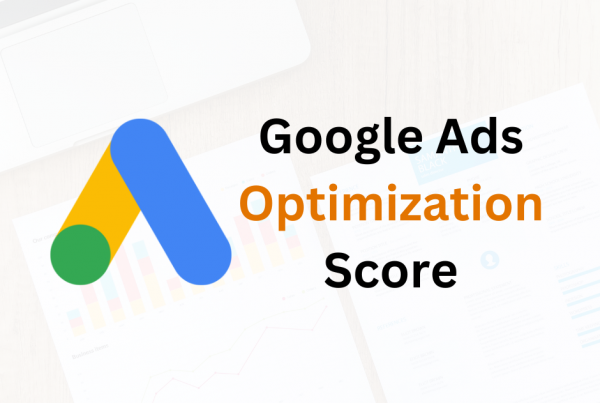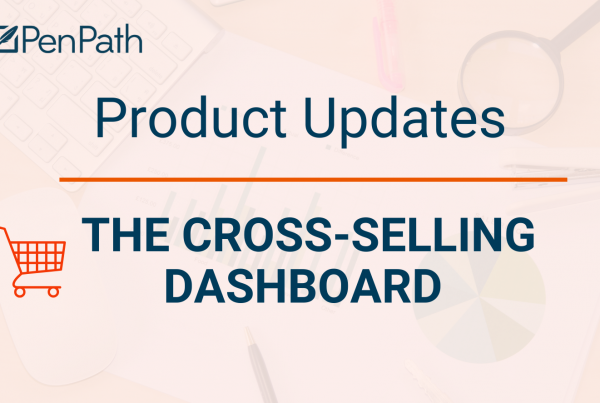Imagine what would happen if sales pipeline data (Salesforce) and website data (Google Analytics) could work together.
You’d get a clear image of the full end-to-end process, from the moment a person gets to your website to the moment that person decides to pay for your products or services, both the first time and as a repeat customer.
From that full customer journey map, you could then calculate lead scoring for customers and discover who and where your most valuable customers are.
Today we’re going to be talking about how to do that. In our last article, we showed where to find website data and sales pipeline data. This time, we’ll show you exactly what you get out of blending that data.
Table Of Contents
-
- Current Customer Journey Mapping Needs An Upgrade…
- Looking At Side By Side Web + Sales Macro Data Gives A Holistic Understanding
- Taking Action: Establish Sophisticated Lead Scoring and Audiences For Your Business
Introduction:
Once combined Salesforce and web analytics data become available, there’s so much you can do with it! Unfortunately, most marketers don’t have enough time to discover what’s possible so they’re content with what the market can offer.
Here’s the thing: most software is designed for a mass audience. But each business is unique, so the standard metrics and capabilities might not be enough.
By combining sales and web data, you can intertwine your sales + marketing departments for better advertising and analytics.
By seeing how your leads, opportunities and conversions are using your site, you can customize your campaigns to their reactions.
For example, tracking sales journeys across campaigns and channels becomes easier if you know that your leads tend to look at 5 top blog posts, and 1 of those posts creates the most opportunities.
Based on that information, you can analyze what’s working and use it to drive future traffic to your site.
You can also compare and contrast Web + Sales data in one place: for example, seeing your Salesforce conversion funnel vs. your Google Analytics web traffic side by side for the same date.
If there’s a dip in your traffic, you can see if it affects the amount of leads and opportunities you have. Or, if your sales funnel is not at all affected by highs and lows on your website, you can gather that maybe your site could be working at a higher level to impact your sales.
This can also lead to better lead scoring.
Let’s take a look at how current marketers usually function, instead of having access to the above.
1. Current Journey Mapping Needs An Upgrade…
Salesforce has a good way of explaining how marketing and sales departments worked differently in the old days of business:
“Marketing teams had databases that outlined all their campaigns and activities. They looked at views, impressions, open rates, CTR, etc., to generate baseline metrics for engagement.
On the other hand, sales teams dealt exclusively with leads. They maintained their own database with prospects. They either purchased leads from other vendors and made outbound calls, or they fielded inbound orders and calls from websites and stores and pushed for additional cross-sale and up-sale.”
Nowadays, it is even more complicated because marketers have to deal with different metrics for social media, email marketing, website data and combine that with sales data.
However, if you get it right, tracking a potential customer as they go from website engagement to talking to salespeople and then converting can be a very smooth and straightforward ride.
Marketing has become Digital Marketing in this age, and you’d be surprised to know it still functions like the old days of marketing – very siloed. Google Analytics, one of the most popular web analytics software, only gives very basic journey mapping as a default. 

Source: Online Behavior This does not take into account the sales team, which is the other half of the equation when it comes to customers.
It’s still shocking that although we have become very “advanced” in terms of integrating marketing with the Internet, marketers still need expensive box 3rd party integrations like Salesforce to even think about combining similar types of data such as sales and website data.
And of course those very box solutions might not even have the customization that most businesses want. The focus is not to provide a tailored solution based on each company’s marketing + sales department needs, but to sell very basic features that can be slapped onto every business. To get more advanced features requires an expensive consultant who is specialized in that exact software – so now you are paying for the software and a person to handle it for you.
Basically, you need to adapt and adjust to what the software offers, instead of the software forming itself around your needs. This might work for large enterprises but for small to medium businesses, it’s too much.
Let’s talk about a solution below.
2. Looking At Side By Side Web + Sales Macro Data Gives A Holistic Understanding
So the possible solutions have been to hire a consultant who specializes in the exact big box software your company has – if you decide to switch software, all the work put into that software is gone.
Another solution instead of that could be to have a data analyst on the team whose job it is to piece together different types of data – for example Google Analytics and Salesforce data.
But they might only know how to work with limited types of data, might not know the programming to extract that data…
It seems like data is a big buzzword but people are not really sure how to exactly configure it to help a business’s needs.
Here’s where PenPath comes in.
Our company is a combination of consulting, service and technology that creates marketing intelligence dashboards. What this means is that you don’t have to pay for the underlying software we use to create our dashboards.
There is no big box solution to manage.
We’re one of the only marketing intelligence companies that form solutions around your businesses’ needs, instead of trying to convince you your business’s unique needs just happen to be fixable by the generic solution we offer.
We also provide consulting as a part of what we offer, so it’s not something extra you need to get.
Below is an example of what a macro, high-level version of sales + website data look like together. Finally you’re able to combine marketing and sales data in one dashboard. No switching tabs, no extra screens. Website users are combined with MQLs and SQLs in graphs and conversion funnels like they were meant to be.
Because we work with many customers, we have proven dashboards we know are a big hit. We also have custom dashboards we make after many conversations with you, so they are personal and valuable.
An example below shows how connecting Salesforce with Google Analytics can lead to forming a customer funnel journey for marketers who use a CRM.
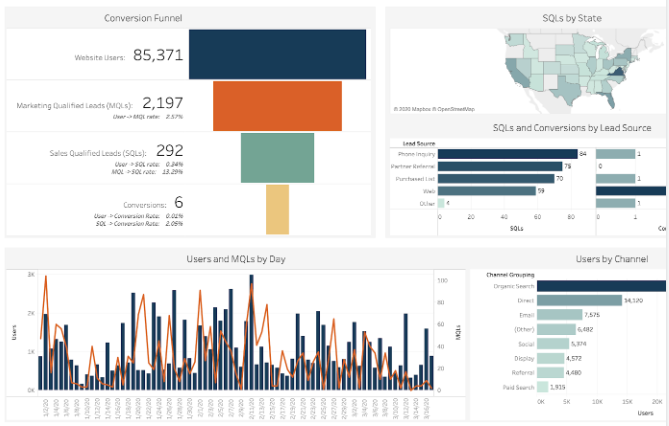 Source: PenPath.com
Source: PenPath.com
3. Taking Action: Establish Sophisticated Lead Scoring and Audiences For Your Business
So all of this is super, super cool, but what is the use of data if it can’t help your business? Other than improving campaigns, how can marketers use sales + website data together? One way is to make lead scoring an advanced technique both departments can use.
Hubspot says lead scoring is “the process of assigning values, often in the form of numerical “points,” to each lead you generate for the business.” If a certain amount of leads came mostly from organic search vs. a very expensive campaign, now you have an audience you know works for you!
Based on that, you can calculate that a lead from organic search would be worth more than a lead from doing a similar campaign.
Of course, this could change if the fewer campaign leads were the ones that actually converted, then those would be worth more.There’s so many ways this can be done.. Let’s look at a typical lead scoring model below.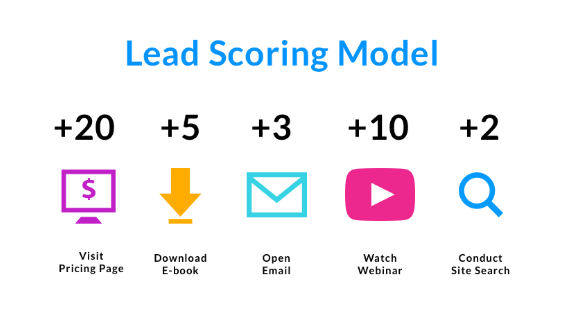
Source: UseProof This looks like it’s lead scoring only based on digital marketing metrics. But because we can combine sales and website data, you’re able to have scores from both.
For example, a sales lead score could be +10 per phone call with a salesperson as a client moves up the sales funnel. They could also be assigned website lead scores, say if they read an article or signed up for the newsletter in the meantime. The combination of Sales and Website data makes for some powerful, sophisticated lead scoring that would not be possible with either alone.
You’ve already seen that combining types of data can lead to more trail-blazing marketing and advertising.
You’ll understand your customer even more – who they are, where they go on your website, and how many conversations you need to have before they convert. You might also see what the average number of conversations is before they purchase, or how many times they need to visit the website.
Creating goals and targets based on those metrics happens naturally then.
If any of this looks intriguing, then PenPath might be right for you. We’re looking for data-driven marketing folks who want to understand their customer and are frustrated at the lack of good or simple options.
Sometimes it might feel like you need to buy 10 different types of software to get one workable solution fit for your business.
We’re not for people who are satisfied with generic, big box solutions – we want the ones who are constantly trying to innovate and understand their distinctive customer and data.
Let’s have a chat and talk about what possibilities we can create together.

